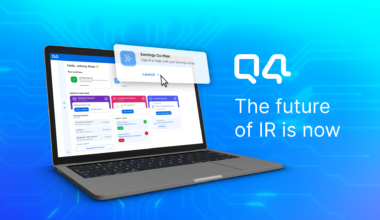Adjusting to the ‘new normal’ has meant a variety of changes in our everyday life and the way we work. As reporting season comes to an end, IRO’s will begin to prepare for their non-deal roadshows (NDR) without the ability to travel and have in-person meetings. The solution? Taking NDR’s virtual.
Determining the technological requirements of going virtual isn’t the only piece of the puzzle. IROs will not only be presenting, but also preparing for NDR’s through a totally new format. That being said, in planning a virtual NDR, there are some important practices that can help you take your in-person NDR online and effectively share your story to investors. Here’s what you need to know.
Consider taking your NDR international
Since NDR’s are no longer bound by geography and travel, why not take your NDR international? This opens up a whole new opportunity to meet with investors worldwide that you may have not been able to connect with as easily before. Going virtual removes the logistical issues of navigating a city you’ve never been to removing the risk of a hit to overall ROI. According to Billy Eckert, Head of Surveillance and Capital Markets Intelligence at Q4, “Geographical targeting can be a big deal, especially when you look at some of the large capital centers of North America. If you are underrepresented in any one of those pockets, and there’s interest in the peer group, that can be a great opportunity for both management and IR to get in and fill a valuation gap with a region that might not have as much familiarity with your story, but should.” This is the perfect time to connect with interested peer groups outside of typical capital centers and look beyond home markets.
Connect leadership with the right investors
Though circumstances have changed, your CEO’s time is still valuable as ever. To make the most of their time (and yours), it’s critical to spend your time wisely by engaging potential investors who could add real value to the business, not just “tire kickers”. This means targeting effectively and connecting your C-suite and leadership with the right investors. In addition to targeting existing shareholders through ownership data, Amit Sanghvi, Q4’s Managing Director, Europe notes that IROs can effectively find non-holders through use of technology. For example, Q4’s AI Targeting tool leverages both capital markets intelligence and machine learning to uncover the most ideal investors. The algorithm analyzes more than 700 factors to predict which investors are in the best position to buy your stock over the next 90 days. But Amit adds, “we’re seeing early adoption work best, in tandem with the qualitative feedback of brokers and intelligence analysts.” Leveraging the right technology along with your team’s intel can help ease the burden of targeting and ensure you’re spending your time efficiently.
Keep things brief, but impactful
In this time of uncertainty, everyone is scrambling for information and you want to provide clear, valuable information that effectively delivers your company’s story. One of the key differences between presenting virtually versus online is that it’s much more difficult to hold someone’s attention through your phone or computer. There can be a multitude of distractions and in light of this, Elizabeth Saunder, Partner at Claremont Partners states that it’s important to shorten your roadshow down to 6-8 slides and have the rest live in the appendix. Before you go into the presentation, ensure that you stay on track (and on time) by having 4-5 key things prepared that you want to get across. Additionally, have a list of questions for your IRO to pose that the new investor should be asking, ensuring the essential questions to understanding your story have been asked.
Treat it like an in-person meeting
Sometimes virtual meetings can be perceived as casual and presenters don’t plan and prepare the same way they would for an in-person NDR. However, Matt Tractenberg, IR Partner at Q4 insists, “it’s imperative to prepare just as thoroughly and place as much value on [virtual NDRs] as if it were an in-person roadshow. This includes embracing video when and if you can.” If the virtual medium is still new to you, it’s important to remember how much your body language matters. Just as if you were in a boardroom, how you communicate verbally as well non-verbally can make a big impact on the delivery of your story. Throughout your meeting, try to remain conscious of your posture, tone, and eye contact. As well, be mindful of others, keep an eye out for the body language, and non-verbal cues from investors. This means reading the room throughout your presentation, knowing when to stop for questions or comments will help to create a smooth virtual NDR.
Prepare your technology and logistics
As mentioned earlier, though determining technology requirements isn’t the only piece of the puzzle, it certainly is an important one. Finding a provider to host your virtual NDR can alleviate much of the heavy lifting when hosting a virtual event. On your end, the items left to consider are ensuring that there is available bandwidth and a stable internet connection in your space. You also want to make sure that you have a space in your home that has good acoustics, ie. away from a busy street or loud hallway so that nothing will impact that quality of your audio. Test both audio, video, and internet connection ahead of time to ensure a smooth, glitch-free meeting.
Hosting a virtual NDR is new territory, but by taking the necessary steps and preparing effectively you can host impactful meetings with investors. To learn more about best practices in taking your in-person events online, download our Virtual Events guide, here.


